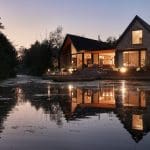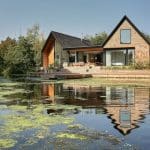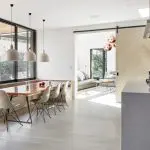Roger Hermiston & Eileen Wise make the short trip to the Norfolk Broads to stay at Backwater, and glory in the wildlife and boating before visiting Houghton Hall.
It was just after sunrise at our secluded private lagoon on the edge of the Norfolk Broads, and the ‘Tarka the Otter’ screenplay was about to welcome its star actors.
Already we had seen the heron – ‘Old Nog’, with his familiar cry of ‘Kra-a-ark’ – beating his loose grey wings en route to his perch on a tall tree stump. The kingfisher – ‘Halcyon’ in Henry Williamson’s famous novel – had sped down the river, uttering its short cry of peet as it skirted the alder and birch trees on the wet woodland. The resident swan couple had gone their separate ways around the channels of the lagoon, gracefully navigating the water lilies on their daily perambulation before reuniting at their home near the deck of the house.
Then, as if on cue, the main performers swam out a few yards from the reed beds, their smooth brown bodies flipping in and out of the water, rolling, cavorting, enjoying some early morning exercise. A mother otter and her two cubs. A beautiful, magical sight if only for couple of minutes and then these shy, elusive creatures were gone.
Backwater on the Norfolk Broads
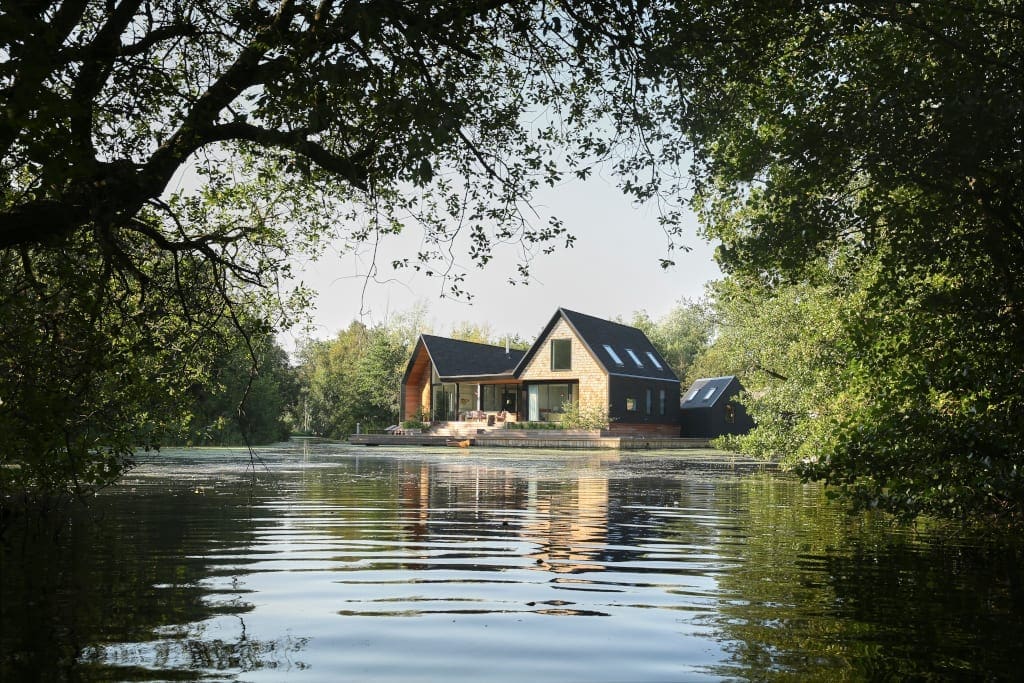
These are the treats in store if you come to stay at this waterside holiday home called Backwater, situated on the very edge of Wroxham, the ‘capital’ of the Norfolk Broads. Take the fibreglass canoe from Backwater’s deck and you can explore more of the wildlife when you head out into the Broads and the River Bure – you will eventually hit the North Sea if you keep going.
Backwater is the stunning creation of London architect Patrick Michell. Back in 2012 Patrick was looking for a holiday home for his family, preferably not more than two hours from the capital. Sites in Kent, Sussex and Suffolk were all considered, but he had connections to Norfolk, with his grandfather – a Commander in the Royal Navy – living in Old Hunstanton. ‘Messing around in boats’ was a key part of his childhood.
The search for a site eventually yielded a rundown 1950s timber home, an ugly-looking bungalow at the end of a long private road in Wroxham with its timber piles rotting as they sank into the water. Once he had knocked it down, Patrick set about building a house that would incorporate the Edwardian-style architecture of many of the local industrial boat buildings with his own contemporary design.
Backwater Award-winning Architecture
The result is amazing – indeed award-winning, with Backwater’s transformation honoured by RIBA (Royal Institute of British Architects). It is now a grand 165-square metre timber-framed house, sat on a steel subframe, surrounded by water on three sides. Inside the home, underneath three pitched bays – echoing the working boat sheds found on the Broads – are three distinct living spaces, one incorporating the bedrooms and bathrooms, the middle one the kitchen and dining space, and the third the living-room, snug and study.
Backwater Norfolk Broads Photo Gallery
Over the decking outside the living room is an 11-foot overhang which protects while you’re sunbathing, but also allows you to sit outside and enjoy the views with a hot chocolate while the rain comes teeming down.
Inside, Blackwater is light and airy, a spacious stylish modern home. All the floors – with underfloor heating – are done in whitened oak. The huge black and white kitchen has everything you might need, together with a long table by the window that could sit twelve.
The house, with four comfortable bedrooms – two on the ground floor, two up a spiral staircase on the upper floor – is designed to accommodate a couple of families, if necessary. The study behind the living room also has a bed, and a desk, and an eclectic library – Aesop’s Fables, James Joyce’s Ulysses, thrillers, and books of local interest.
The art on the walls is intriguing too. We were drawn to the two prints by Rennie Pilgrem (formerly a well-known electronic music producer) – one called Fire, an eerie picture of two barns, one seemingly alight with a yellow glow seen through the window, while the other, a more whimsical and topical creation, is called Rowing Coach on Holiday, featuring a man on a boat with a loudspeaker, apparently issuing instructions to a trailing family of mother and ducks.
Wroxham, Capital of the Norfolk Broads
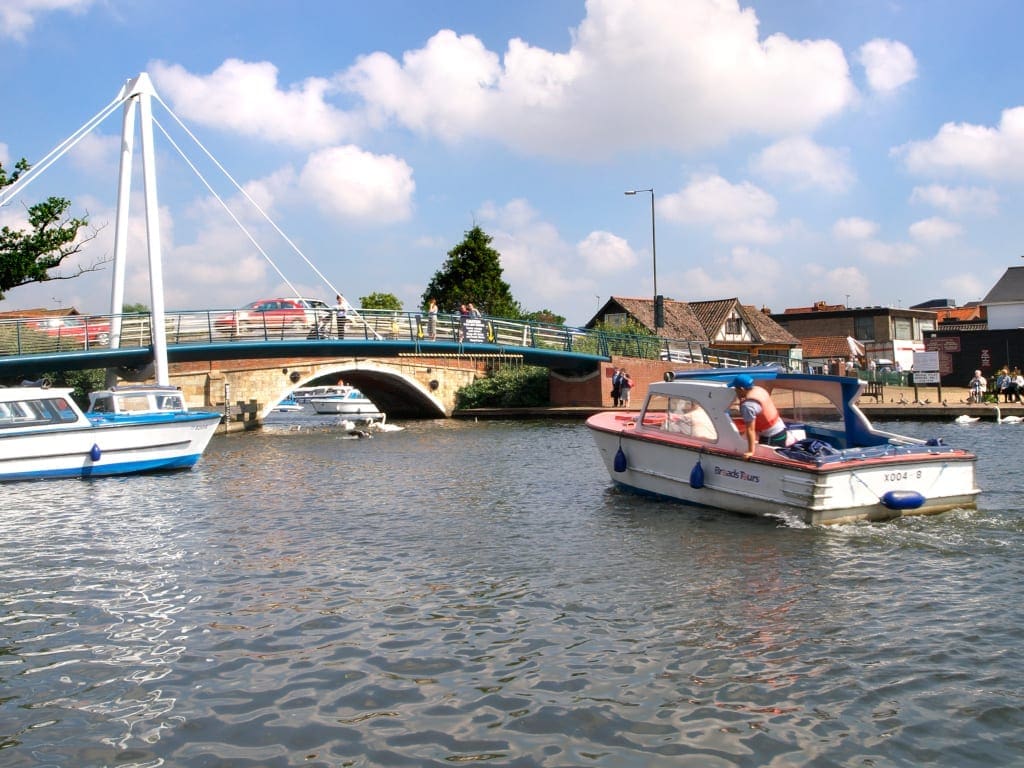
After a rather damp day, on our arrival at Blackwater we were happy to relax with our novels in front of the warmth of the wood-burning stove, later getting into more competitive mode with a few games of scrabble.
After the otter excitement on the water the following morning, we headed out, first to get acquainted with Wroxham. It appeared a busy, utilitarian sort of town, full of cafés and fish and chip shops, with the focal point being the massive classic department store of Roys (which is technically in Hoveton), a throwback to a past age, but still thriving in the present one.
Little Wroxham Bridge is a popular central meeting point, where hundreds of pigeons vie with the River Bure’s swans for crumbs from visitors. The author Arthur Ransome described well the hustle and bustle of riverside life in Wroxham in his 1930s novel Coot Club, “boats everywhere, from the big black wherry with her gaily painted mast …. to the punts of the boatmen going to and fro … motor cruisers filling up with petrol ….and the hundreds of big and little sailing yachts tied to the quays”.
Much of the same spirit still remains, if not quite the numbers of the 1930s. Yet on the day we stopped by there were a good number of visitors, undaunted by the pandemic and relishing a rare day out.
Norfolk Broads Boat Trips
You can’t visit the Norfolk Broads without getting into a boat and exploring one. There are 63 broads – lakes that were formed by the flooding of peat workings in medieval times – in addition to seven rivers in the region. Hosted by the hospitable Norfolk Wildlife Trust, we joined a small party and headed out to explore the largest one – Hickling Broad.
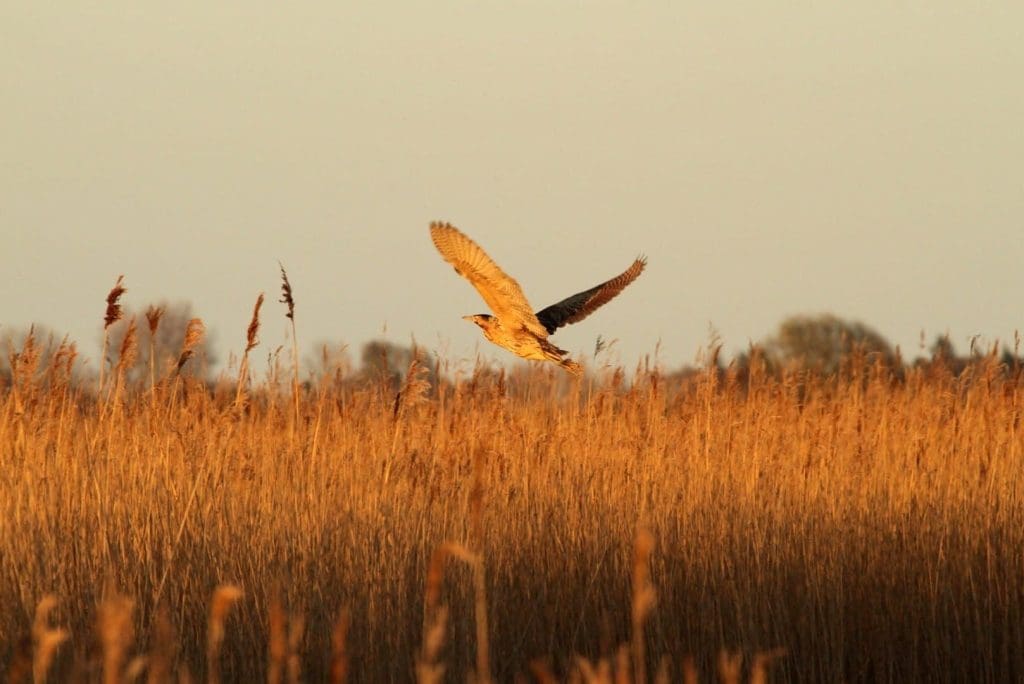
Our skipper was Trevor Gray, a schoolmaster in his previous incarnation, who has now worked as a guide on the boats for five years. He revels in a quieter, more reflective job, and has all the fascinating history of the waterway at his fingertips.
If you were lucky you might see the common crane on Hickling Broad (a significant percentage of the UK population is here): it would be a red letter day if you caught a glimpse of the famed bittern. As it was, we settled quite happily for cormorants, red kites and marsh harriers, and – something of a coup – the bearded tit.
Found only in large clumps of reed, unlike their back garden cousins, the male bearded tit is a rich tawny colour with black and white wings and a pale blue head. The ‘bearded’ notation reflects the splendid Victorian gent’s ‘waxed moustache’ hanging from both sides of its bill.
Pulling up alongside Turner’s Island, the bearded tit seemed reluctant to come out and show itself. A couple of us resorted to the crude device of playing the sound of the bird on our iphones from a Youtube film, and lo and behold it seemed to work. Responding to the noise, a good number of bearded tits emerged from the reeds and showed themselves in their colourful glory.
Turner’s Islands, Norfolk Broads
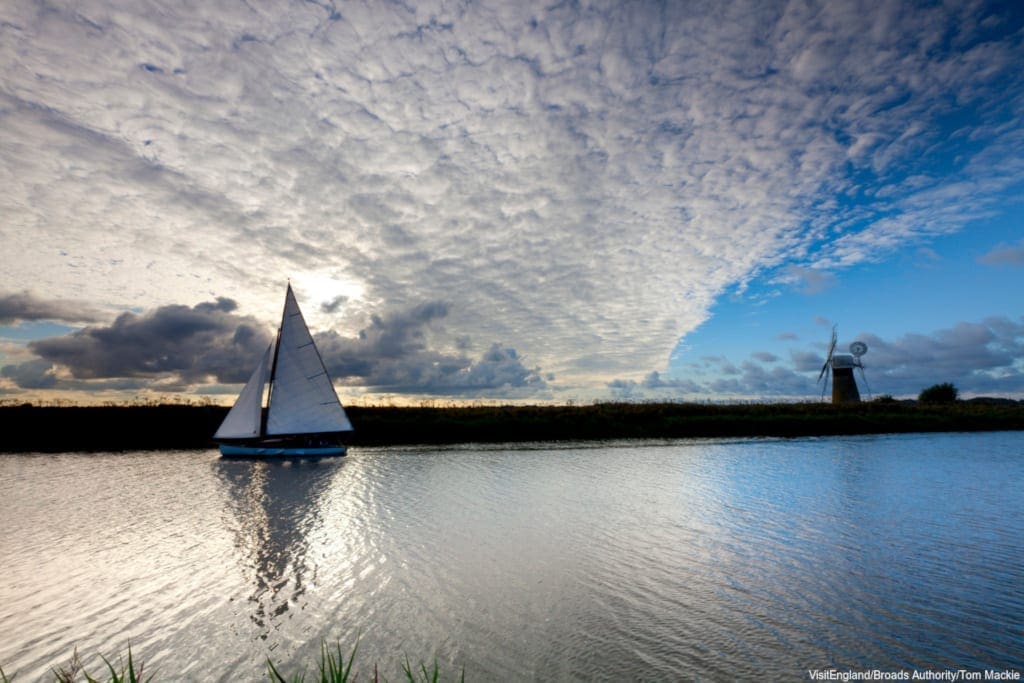
Turner’s Island is named after Hickling Broad’s most famous visitor – and inhabitant – Emma Louise Turner, an English ornithologist and pioneering bird photographer. This remarkable Victorian woman, daughter of a wealthy grocer and draper, did not take up wildlife photography until she was 33, but it then became her life’s passion.
She visited the Norfolk Broads for the first time in 1901, and then for a quarter of a century lived and worked for part of each year – including two winters – at Hickling Broad, mainly on a houseboat with her cat but also on a spartan hut on the little island that bears her name.
Trevor described to us Turner’s greatest moment – sealing her place in the pantheon of ornithologists – which came in July 1911 when, with a local gamekeeper, she discovered a recently fledged bittern, a species that had not been recorded as breeding in Britain for over a quarter of a century. Her evocative photograph of the young bittern remains one of the most iconic images of it, or indeed any other bird.
An afternoon on the Broads had built up our appetites, so in the evening we negotiated the rough and exceedingly wet track and road from Backwater – we arrived two days after the wettest day on record in the UK – in order to dine at Liberty, a restaurant perched by the side of Wroxham Bridge. In a most hospitable environment, where we enjoyed mixed seafood tagliatelle and pan-fried salmon fillet washed down with a bottle of Pinot Grigio.
The following morning we reluctantly departed Backwater to make the 90-minute journey back to our Suffolk home – but not before making a little detour to a place that we had always wanted to visit, but which always seemed closed on our various forays through Norfolk.
Houghton Hall, in West Norfolk
We live in a cottage at Houghton Hall, Suffolk – a little hamlet bearing the name of its central moated farmhouse, set in 500 acres, which can trace its history back to the Doomsday Book. But we were now en route to the ‘other’ Houghton Hall, in West Norfolk, the home of first prime minister Sir Robert Walpole, and probably the finest surviving Palladian house in England.
Sir Robert, who certainly enjoyed the best things in life, commissioned the country’s most famous architect, Colen Campbell, to build this stately home, and then employed its best interior designer, William Kent, to fashion its ornate, massive rooms.
Kent planned his work knowing that Houghton Hall had to accommodate Walpole’s astonishing art collection – 400 paintings at its height, with works by Van Dyck, Poussin, Rubens and Rembrandt amongst many others. After Walpole died in 1745, his successors ran up debts, so much so that the bulk of his collection had to sold to pay them off to Catherine the Great of Russia – and the Hermitage Museum in St Petersburg still owns more than 120 of them.
For all that he lavished on Houghton Hall, Walpole would only visit twice a year – although it was for two or three weeks at a time, when he would hold the occasional cabinet meeting before indulging his colleagues and friends.
With pandemic restrictions in place, we could only visit two of Houghton Hall’s rooms – the Red Saloon, and the Stone Hall. The former is the most elaborately decorated, gilded and furnished of all the rooms; amongst its splendid artwork is a representation of Apollo driving his chariot of the Sun on the ceiling, paintings of Sir Robert as a young man, and a huge portrait of the Hall’s ‘benefactor’ Catherine the Great.
Anish Kapoor at Houghton Hall

The other reason we made a beeline for Houghton Hall this time was to view an exhibition of works by the celebrated British sculptor Anish Kapoor. The current owner of the hall, David, Lord Cholmondeley, the 7th Marquess, is a keen patron of the arts – and sculpture in particular – and has facilitated exhibitions in this historic setting by such artists as Damien Hirst, Henry Moore and Richard Long.
Kapoor has eight painted concave mirrors displayed in the Stone Hall, but the bulk of his twenty-odd exhibits are spread around the hall’s vast, formal gardens. At times, walking around, it feels as aliens have landed and discarded their artefacts in this manicured landscape, but actually the striking contrast works superbly.
Kapoor’s reflective, mysterious work is absorbing, and his fascination with the physics of light is no better illustrated than with the centerpiece of his show on the west lawn, Sky Mirror. This is a five-metre diameter stainless steel concave mirror angled up towards the heavens, which effectively brings the sky down to the ground, enabling you to study – and feel part of – its mutable brightness and the movement of the clouds.
Having been up in clouds in the final moments of our mini-break, it was back to earth and time to return home – to our Houghton Hall cottage.
Backwater on the Norfolk Broads
Available from £1,100 for three nights depending on the season. Click here for more information.
Houghton Hall
Open Wednesday to Sunday from 11am to 4pm (last entry). All tickets must be pre-booked.
Things to Do on the Norfolk Broads
For more information on what to do on the Norfolk Broads go to the Visit Norfolk website.
